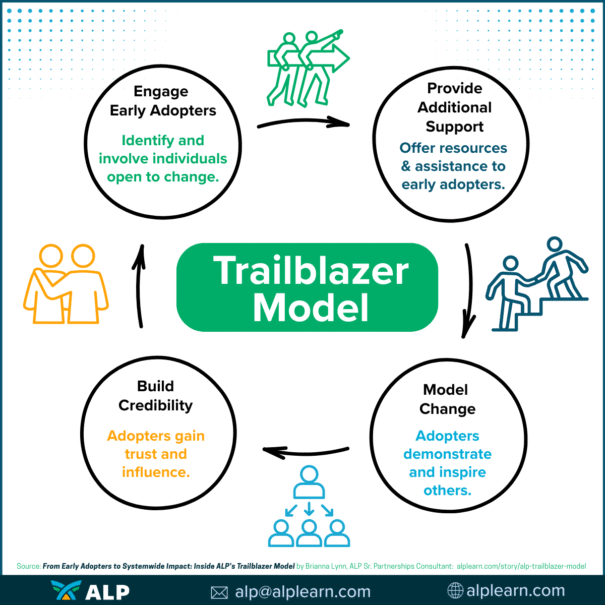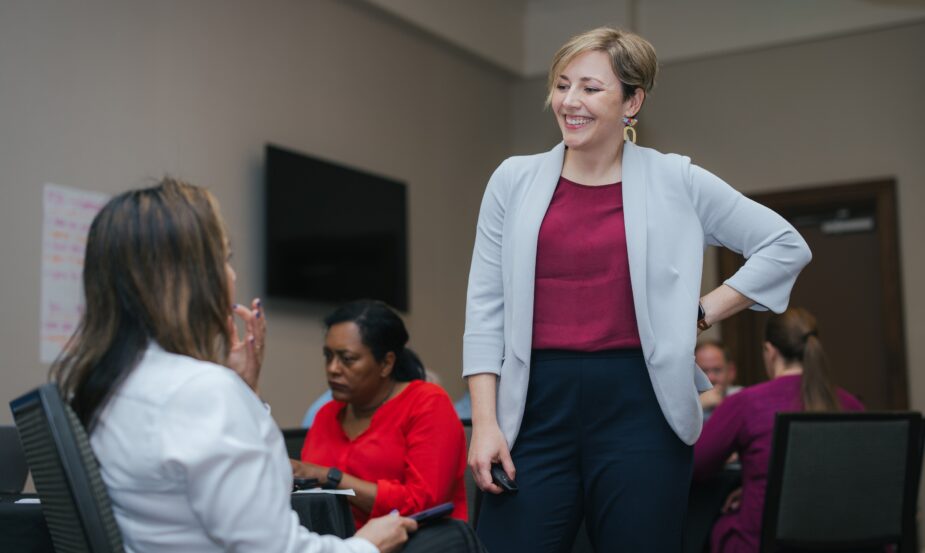School and district leaders aren’t short on ideas. They’re managing strategic plans, tech rollouts, instructional shifts, and an evolving landscape shaped by tools like generative AI. The challenge isn’t coming up with something new—it’s making meaningful changes that last.
Drawing from her experience as a teacher, coach, and systems-level partner, Brianna Lynn, Senior Partnerships Consultant at Advanced Learning Partnerships (ALP), shared a model that addresses this challenge head-on. She explained how ALP’s Trailblazer model helps education leaders identify and support internal champions, people who can move change forward from within their own schools, and give them the coaching and structure they need to scale change, one step at a time.
This post distills Brianna’s insights on what makes the trailblazer model work, how to know if your system is ready for it, and what to expect when it’s implemented with intention.
Why Traditional Rollouts Fall Short and What to Do Instead
When a new initiative doesn’t take root, it’s easy to blame the strategy. But more often, the gap isn’t in the plan, it’s in the implementation. Districts may invest in new tools or approaches, but without the right internal leadership, the work struggles to gain traction.
That’s why ALP begins with a simple set of questions:
- What are your most pressing challenges?
- Where are people struggling to move something forward?
- Are there educators who already believe in the change but need more support?
When we hear things like, “We’re seeing isolated success, but not across the system,” or “We rolled this out, but it never really caught on,” we may suggest the Trailblazer model as a next step.
The Trailblazer model pairs individual coaching with collaborative cohort learning to support early adopters as they implement, refine, and model new practices within their school system.
Traditional change models may adopt a rolling approach—start with freshmen and add a grade each year. Another change model may try a one-size-fits-all approach where every individual affected by change is required to complete a course or attend an all-day training. The hope in this approach is that the training is effective for enough people who apply it in their work.
ALP’s Trailblazer Model can be used to augment traditional change models or completely supplant them. It’s designed to be job-embedded—a coach observes educators and administrators within their specific role, coaching them from their observed, unique, specific school or district context. Rather than compliance, the Trailblazer Model emphasizes starting with early adopters and willing leaders of the change. In exchange for their willingness, they receive additional support to adopt change. Through the extra support they receive, they are more likely to model change in a way that builds credibility with their peers and leaders. This is how change scales authentically and with co-ownership rather than top-down compliance.
Selecting the Right People: How to Identify Effective Internal Leaders
Not every capable educator is the right person to lead a new initiative. Some are already overcommitted. Others may be skeptical. The Trailblazer model works best when leaders take the time to find the people who are ready, not just professionally, but emotionally and logistically.
“We’re thoughtful about who joins a Trailblazer cohort,” said Brianna Lynn. “The success of any change effort depends as much on who leads it as what it’s trying to achieve.”
ALP supports leaders with two simple tools to guide the selection process:
- A Profile of a Trailblazer, which outlines key qualities like curiosity, openness, and availability.
- An Invitation to Trailblaze, which clearly communicates the expectations and benefits of the experience.
The goal isn’t to recruit the people who already have multiple leadership positions. It’s to find those who are open to learning, willing to share with others, and able to take on something new without burning out. That kind of leadership builds internal momentum and helps others see what’s possible.
How Trailblazer Cohorts Work (and Why They’re Built to Last)
Once a Trailblazer cohort is formed, each participant is paired with a coach. That coach provides one-on-one support embedded in the educator’s daily context—observing, offering feedback, and helping the participant align the change to their role. In parallel, cohort members meet together to share progress and challenges.
Each Trailblazer experience is shaped by the district’s needs. Cohorts might include:
- Teachers trying out new approaches to instructional planning
- A cross-functional group learning to use generative AI tools more effectively
- Principals piloting a new leadership practice before rolling it out more broadly
In some systems, Trailblazer work is part of a larger plan. One district might begin with principals, then expand to teacher leaders, and eventually bring in instructional coaches to carry the work forward.
Trailblazers model what change looks like in practice. Their work happens in classrooms, not as an abstract idea.
This embedded practice and coaching allows for experimentation, reflection, and iteration without pulling educators away from their students or piling on extra hours. And because the work happens in the real context of schools, it’s easier for others to see and adopt.

Turning Isolated Success into Systemwide Momentum
School and district leaders don’t necessarily need to add more programs when they could instead scale what’s already working. School and district leaders also don’t need to quietly kill initiatives with value that haven’t yet enjoyed wide adoption. Instead, they can strategically build credibility through targeted support and intentional communication of success.
The Trailblazer model offers a repeatable structure to do just that:
- Identify the right people. ALP supports leaders to identify the right people positioned to build or leverage credibility with their colleagues as well as those who are willing to lead even when it requires vulnerability.
- Invest in their growth through coaching. ALP provides an onsite coach that works with the school day schedule, respects any CBA agreements, and maintains support via asynchronous communication between onsite coaching rounds.
- Amplify their learning through peer collaboration. ALP works with school and district leaders to identify existing collaboration opportunities like PLCs, peer-led professional development sessions, and sharing within district networks. Schools and districts with robust communication teams have also chosen to highlight Trailblazers through a case-study model shared throughout the district and the community.
- Build systemwide trust by leading with internal voices, not external mandates. ALP leads effective change management by supporting a clear vision and strategy from executive leadership (top-down) while simultaneously building grassroots capacity for peer leadership (bottom-up). Common language, frameworks, and goals help scale change effectively throughout education systems.
“People are often more willing to learn from their peers than from someone outside their role. That’s what makes the Trailblazer model work—it builds change from inside the system.”
At a time when education systems are under pressure to do more with less, sustainable change starts by investing in the people who are already ready. The Trailblazer model gives them the tools—and the trust—to lead from within.
Interested in the Trailblazer model for your district or school? Connect with ALP’s team to explore opportunities that fit your leadership journey.
This blog post is based on a conversation with Brianna Lynn, Senior Partnerships Consultant at Advanced Learning Partnerships. Follow Brianna on LinkedIn.

